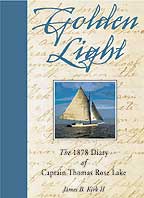BOOK DESCRIPTION
Maritime historian John M. Kochiss describes the magic of reading first-hand history this way: "Unlike any other book before, I found myself mouthing, then almost hearing Captain Lake’s words… And all this alchemy brews forth." And Stephen Dunn, winner of the 2001 Pulitzer Prize for poetry, says: "History needs its passionate pursuers. Golden Light is alive with such attentiveness."
Thomas Rose Lake's life was tied to the sea and the land his family had homesteaded on Lake's Bay — adjacent to Atlantic City, and named for the family. It was a 19th century American life of hard work, close family and community, and strong connection to God and church. At its center was the sailing ship that provided much of the family's living, the Golden Light, a 45_-foot sloop, built in Sayville, New York in 1867.
Boats like the Golden Light "served...as the ‘trailer trucks’ of their age...their main use was to carry oysters from the beds to the market." To this end, Thomas Lake, with his crewmate and first cousin, Dannie, sailed the coast from Virginia to New York and back again, putting in at Lake's Bay between trips. In 1878, the Golden Light made eleven voyages, varying in length from seven to sixty-seven days. She sailed regularly up the coast to New York and down as far as the Chesapeake and Crisfield, Virginia. Sometimes the New York cargo was New Jersey clams, oysters, or fish oil, sometimes oysters or sweet potatoes from Virginia. At other times, the trips to Virginia were made to purchase seed oysters that would be processed and shipped from the oyster platforms at Lake's Bay. Already, by the late 19th century, the oyster population of the upper eastern seaboard had been depleted, leaving Virginia the best and cheapest source of seed oysters.
These were not easy passages: Thomas and Dannie encountered storms and heavy seas, as well as the usual dangers of shoals and narrows. The work was hard and sometimes tedious, but there was excitement too, in races with other boats, in the people they met, in the places they put in. The bustling New York harbor was a fascinating place for two young men from the backwater. The south Jersey oyster fleet tied up in the oyster basin formed a little community of their own with much visiting back and forth. From time to time, Thomas and Dannie went into the great city to the theater, or to Central Park, or "up town to see the Fashens (fashions)" and must have brought many stories back to rural Lake's Bay.
The "essay footnotes" enlighten us with the events and surroundings of the time. It is these fascinating, detailed annotations which make this a historically robust book, placing the diarist — one common man — in the context of his world.
Through the events at sea and on shore over the year, a picture also emerges of the young captain himself. Despite the illness that would soon kill him, Thomas was never idle. His days were full of strenuous physical labor. When not at sea, he would be overhauling the boat, planting, harvesting, working with his father on the oyster platforms, or helping in the family store. Thomas was a gregarious soul and there are many references to social occasions, usually connected to the church or to fraternal organizations like the Sons of Temperance or the Red Men. The church may have mandated weekly "Sunday School", but it also sponsored oyster suppers, "pick nicks" and beach parties. With friends, he made trips to Atlantic City and by train to "Philadelpfia", where they rode the horse drawn "Yellow Car" out to Fairmount Park on the Fourth of July. Again and again he tells us he "saw a good time". Thomas escorted a number of young women to and from these events. He records all their names carefully; however, towards the end of the diary, one, Kate Bowen, stands out. Perhaps they would have married had he lived. He makes time too for outings with his sisters, for "rag sowing" parties, for games of dominoes with family and neighbors, for visits to the sick, for weddings and funerals.
Golden Light provides a rare picture of the all but forgotten east coast oyster trade in the last years of the 19th century, and, as such, is of great value to social historians. Beyond that, however, it is the portrait, indelible and poignant, of the last year in a young man's life. If he knows and fears the seriousness of his illness, he makes no mention of it. He embraces each day, its hard duties and simple pleasures, as though he had a future entire. Clearly, it was a life he loved. A century and a quarter later, it is a life and time we are privileged to see — bathed in the golden light of a younger, more innocent America.
